

EMI Cassette Tapes
#21. Hey Jude (TC-PCS 7184)
(Update: 18th November 2025)




 |
 |
|
|
| Original Inlay
and Tape |
|||
|
TITLE
|
HEY JUDE |
|||
| CATALOG NUMBER | TC-PCS 7184 / 0C 262-06 864 |
|||
|
RELEASE DATE
|
June 1979 / First Issue | |||
| TRACK LISTING | SIDE 1 |
SIDE 2 |
||
| Can't Buy Me Love |
Hey Jude |
|||
| I Should Have Known Better |
Old Brown Shoe |
|||
| Paperback Writer |
Don't Let Me Down |
|||
| Rain |
Ballad Of John & Yoko | |||
| Lady Madonna | ||||
| Revolution | ||||
| CASSETTE CASE AND TAPE |
CASE FRONT | CASE BACK | SIDE 1 --> Click! | SIDE 2 --> Click! |
 |
 |
 |
 |
|
| The cassette cases ("Norelco" cases)
were clear plastic at the front and around the spine area,
and black plastic at the rear. |
The first UK issue has direct print in blue ink
on the shell with Parlophone logo |
|||
| INLAY |
INLAY: FRONT | INLAY: INSIDE |
||
 |
 |
|||
| The front image of the inlay is the
same as that of the album "Hey Jude", but without the album
title printed on it. Parlophone "money" logo on back flap. |
||||
| INLAY: FRONT CLOSE UP | ||||
 |
 |
The Parlophone logomark was printed on the
inlay. "DOLBY SYSTEM" logo was printed on the inlay. |
 |
|
 |
Catalog number "TC-PCS 7184"
and the EMI country code (*1) and DOLBY logo were printed on
the inlay. |
|||
| INLAY: FRONT & INSIDE CLOSE UP | ||||
 |
 |
The phrase "It has been recorded with the
DOLBY B-type noise reduction characteristic" was printed.
Printer name and release date are not printed on
the inlay. |
||
| INLAY: INSIDE CLOSE UP | ||||
 |
"EMI Records
Ltd Hayes Middlesex England" credit and "Made and
Printed in Great Britain" were printed at the bottom of the
inside of the inlay. |
|||
| LABEL CLOSE UP | ||||
 |
 |
 |
 |
|
| "TC-PCS 7184"
catalogue number and "EMI Records Ltd." were printed. |
The Parlophone logomark was
printed on the shell. |
"DOLBY SYSTEM" logo was
printed on the shell. |
NO mark was moulded into
cassette shells. |
|
| LABEL CLOSE UP | ||||
| SIDE 1 | SIDE 2 | Track lists appear
on the cassette label in blue ink. The cassette of the album "Hey Jude" is recorded in the same order as the LP. |
||
 |
 |
|||
| LABEL CLOSE UP | ||||
 |
"Made
in England/Made in U.S.A" was not embossed on the
shell. |
|||
| OTHER ITEM | ||||
| - |
||||
| LABEL | Direct print in blue ink on the shell with
Parlophone logo |
|||
| MIX | STEREO |
|||
| RECORD COMPANY'S NAME | EMI Records Ltd |
|||
| CENTRAL REMARK "SOLD IN U.K." |
- | |||
| RECORDING PUBLISHED CREDIT | (P) 1964,66, 68, 69 |
|||
| INLAY FORM | Custom inlay (Foldover) |
|||
| SHELL | Light Grey Shell |
|||
| CASSETTE CASE |
"Norelco"
cases: clear plastic at the front and around the spine area,
and black plastic at the rear. |
|||
| PRINTER CREDIT | Made and Printed in Great Britain |
|||
| COVER DESIGN/ PHOTO/ NOTES | Photo: Ethan Russell and Monte Fresco |
|||
| PRODUCER | George Martin | |||
| COMMENTS | Direct print in blue ink label
with Parlophone logo cassette. It has a grey tape shell with blue on-body text which suggests a manufacturing date of 1976 onwards. The EMI UK catalog no. (TC-PCS 7184) was on the spine. The cassette cases ("Norelco" cases) were clear plastic at the front and around the spine area, and black plastic at the rear. Hey Jude (original title: The Beatles Again) is a 1970 collection of non-album singles and B-sides by the Beatles. Originally released in the United States and various other markets, but not in the United Kingdom, it consists of non-album singles and B-sides not previously issued on an American Beatles LP; this includes "I Should Have Known Better" and "Can't Buy Me Love", two singles released by Capitol Records whose only previous American album appearance had been on the A Hard Day's Night soundtrack album, which had been released by United Artists Records. It was also available to other countries as an "export" from Britain (Parlophone/Apple CPCS-106) but was not at first issued in Britain, although it was a popular import to the UK. Because of its popularity worldwide, EMI issued Hey Jude in Britain on the Parlophone label on 11 May 1979 (catalogue number PCS 7184). Until the release of 1967–1970 in 1973, Hey Jude was the only way to own the extremely popular "Hey Jude" single on LP or in a stereo mix. The songs "Rain", "Lady Madonna" and "Revolution" were also first mixed for stereo specifically for this album. (*1) EMI country code: 0C 262-06 864 The EMI country codes (introduced on 1 June, 1969): In most cases the EMI Codes are the first two letters of the record's catalog#. These EMI Country Codes were used to indicate the country in which the record was pressed. Note this doesn't necessarily means the record was also released in that country (from Discog). OC / 0C / 1E= UK DOLBY B-type: A Dolby noise-reduction system, or Dolby NR, is one of a series of noise reduction systems developed by Dolby Laboratories for use in analog audio tape recording. The first was Dolby A, a professional broadband noise reduction system for recording studios in 1965, but the best-known is Dolby B (introduced in 1968) for the consumer market, which helped make high fidelity practical on cassette tapes, which used a relatively noisy tape size and speed. From the mid-1970s, Dolby B became standard on commercially pre-recorded music cassettes. |
|||
|
TITLE
|
HEY JUDE |
|||
| CATALOG NUMBER | TC-PCS 7184 / 0C 262-06 864 |
|||
|
RELEASE DATE
|
1986? / 4th Issue? | |||
| TRACK LISTING | SIDE 1 |
SIDE 2 |
||
| Can't Buy Me Love |
Hey Jude |
|||
| I Should Have Known Better |
Old Brown Shoe |
|||
| Paperback Writer |
Don't Let Me Down |
|||
| Rain |
Ballad Of John & Yoko | |||
| Lady Madonna | ||||
| Revolution | ||||
| CASSETTE CASE AND TAPE |
CASE FRONT | CASE BACK | SIDE 1 --> Click! | SIDE 2 --> Click! |
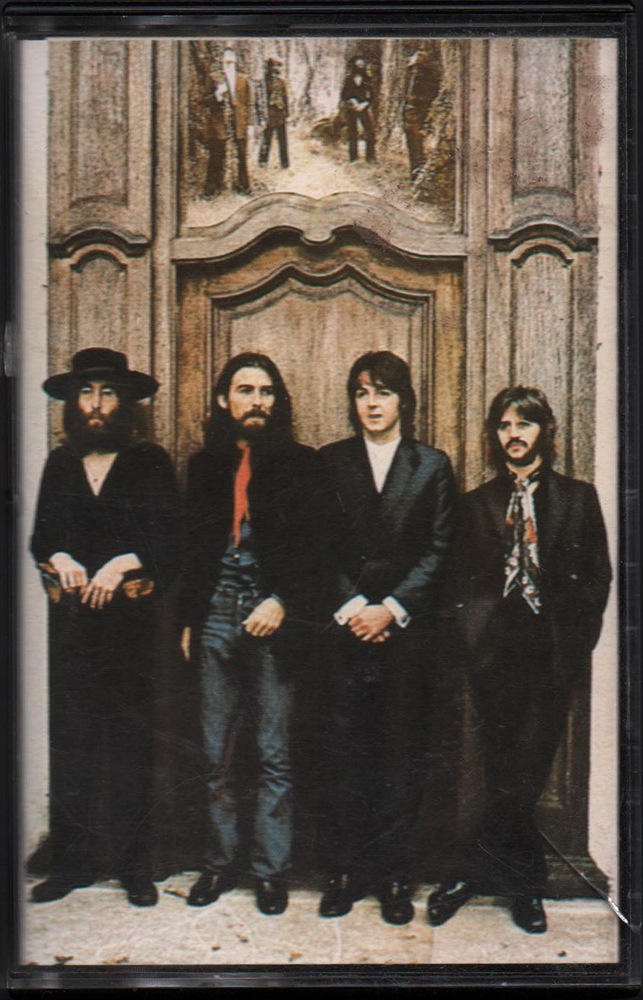 |
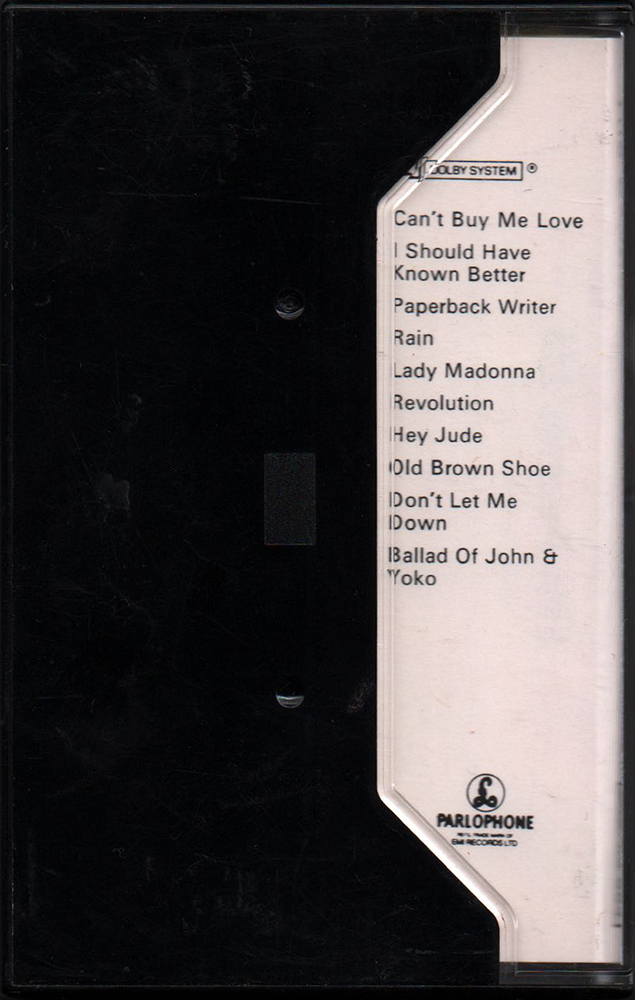 |
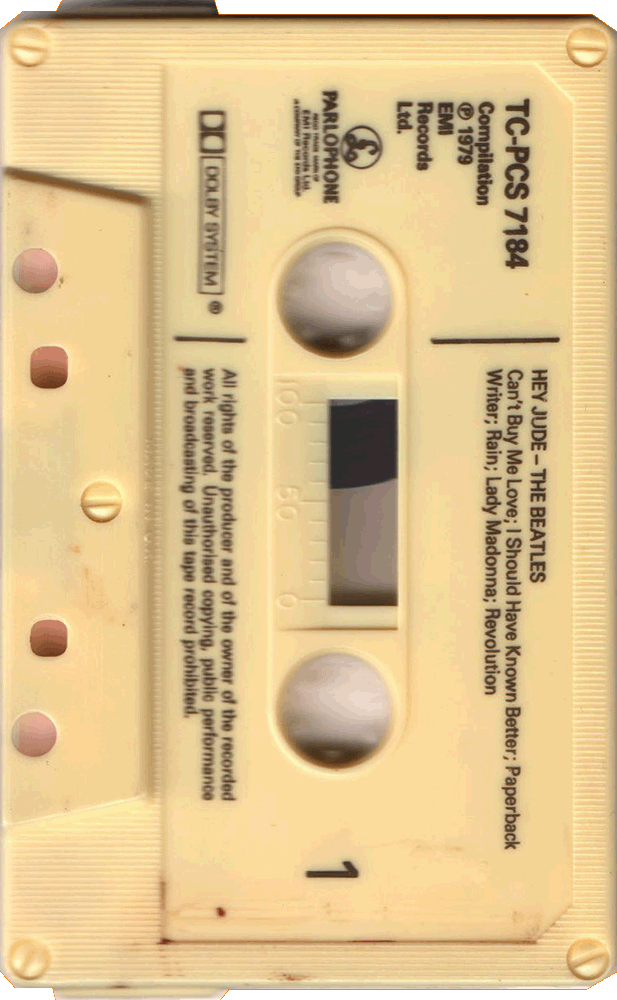 |
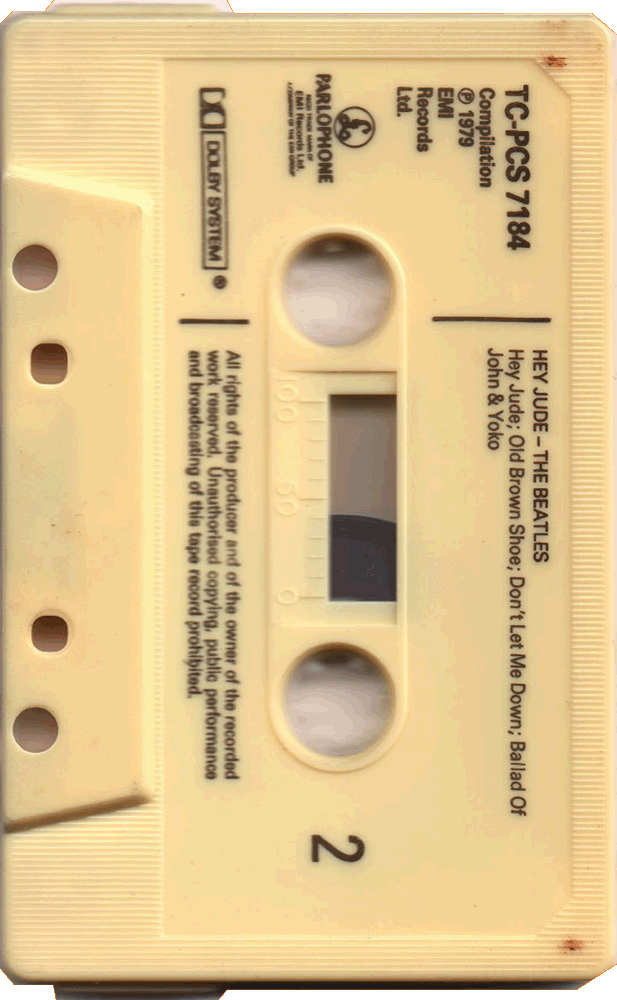 |
|
| The cassette cases ("Norelco" cases)
were clear plastic at the front and around the spine area,
and black plastic at the rear. |
The first UK issue has direct print in black
ink on the shell with Parlophone logo. Cream Shell Moulded Screw |
|||
| INLAY |
INLAY: FRONT | INLAY: INSIDE |
||
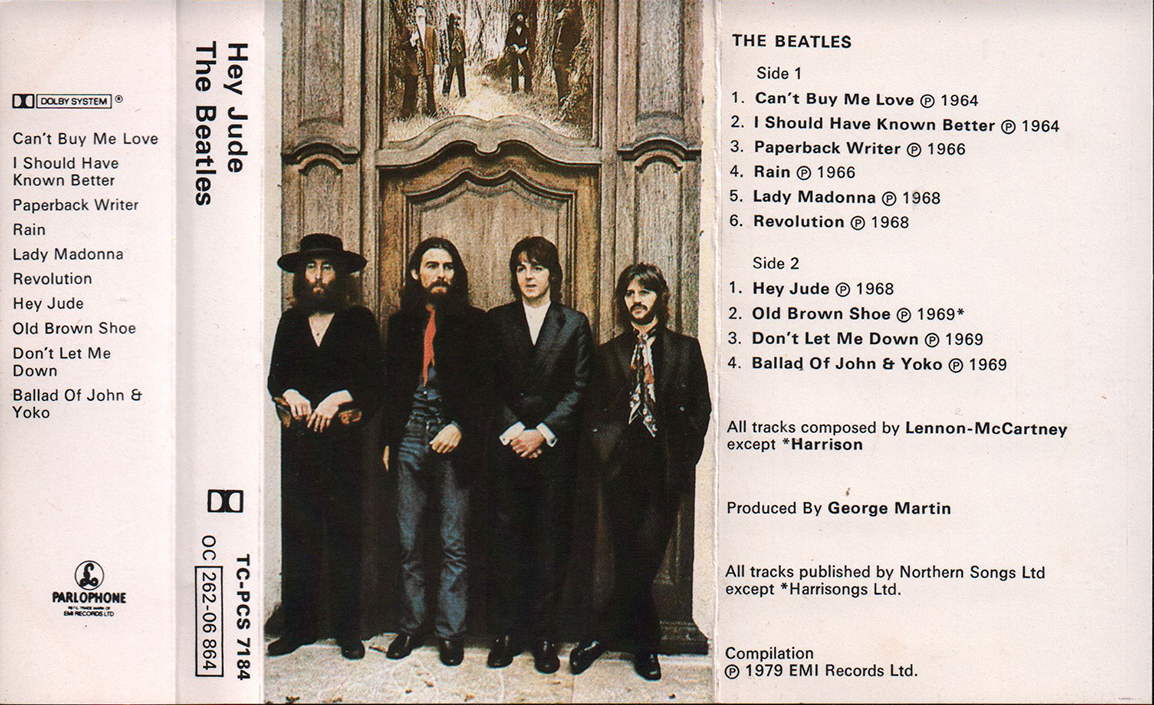 |
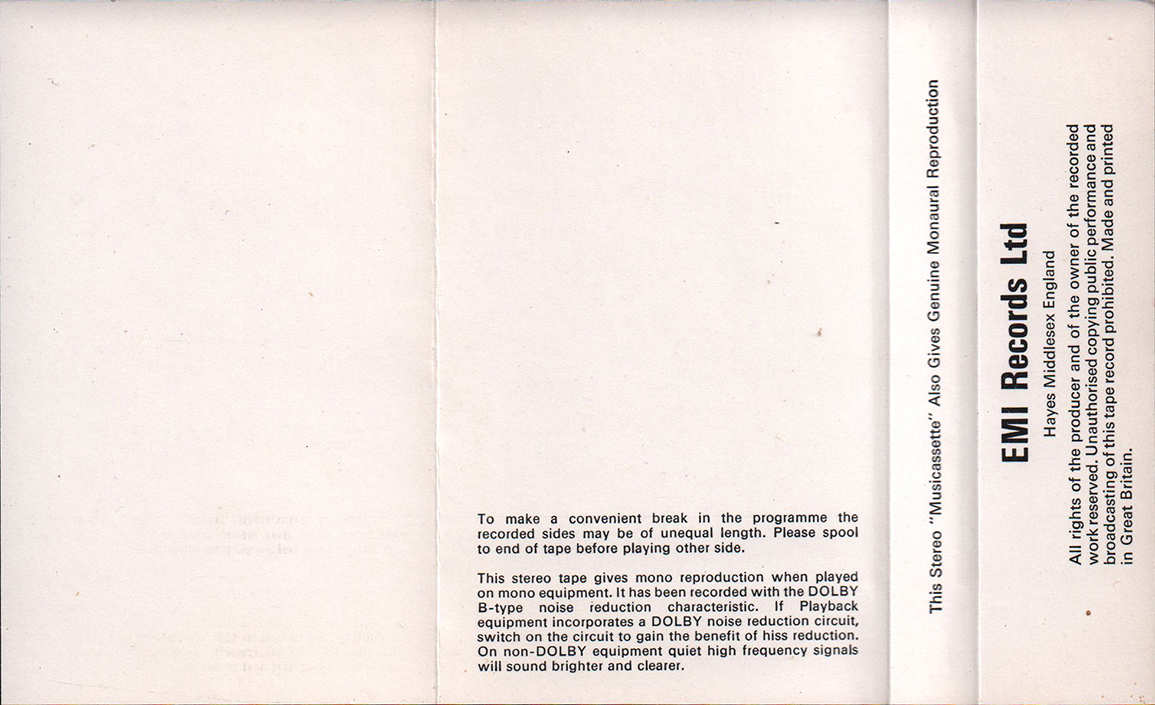 |
|||
| The front image of the inlay is the
same as that of the album "Hey Jude", but without the album
title printed on it. Parlophone "money" logo on back flap. |
||||
| INLAY: FRONT CLOSE UP | ||||
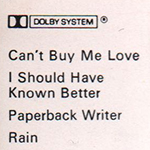 |
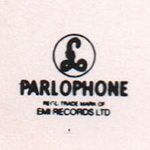 |
The Parlophone logomark was printed on the
inlay. "DOLBY SYSTEM" logo was printed on the inlay. |
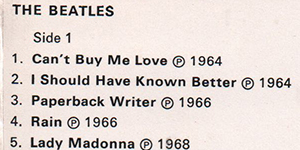 |
|
 |
Catalog number "TC-PCS 7184"
and the EMI country code (*1) and DOLBY logo were printed on
the inlay. |
|||
| INLAY: FRONT & INSIDE CLOSE UP | ||||
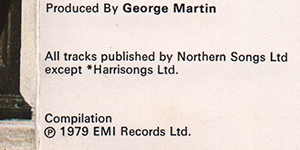 |
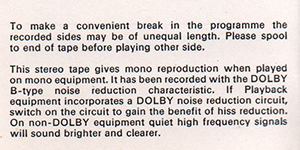 |
The phrase "It has been recorded with the
DOLBY B-type noise reduction characteristic" was printed.
Printer name and release date are not printed on
the inlay. |
||
| INLAY: INSIDE CLOSE UP | ||||
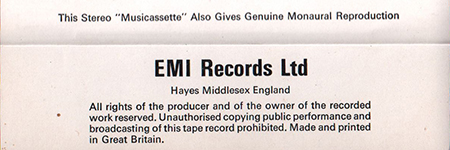 |
"EMI Records
Ltd Hayes Middlesex England" credit and "Made and
Printed in Great Britain" were printed at the bottom of the
inside of the inlay. |
|||
| LABEL CLOSE UP | ||||
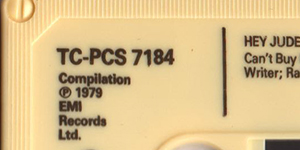 |
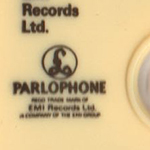 |
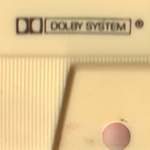 |
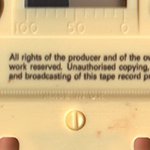 |
|
| "TC-PCS 7184"
catalogue number and "EMI Records Ltd." were printed. |
The Parlophone logomark was
printed on the shell. |
"DOLBY SYSTEM" logo was
printed on the shell. |
Cream Shell Moulded Screw. |
|
| LABEL CLOSE UP | ||||
| SIDE 1 | SIDE 2 | Track lists appear
on the cassette label in blue ink. The cassette of the album "Hey Jude" is recorded in the same order as the LP. Has Recessed window and time scale. |
||
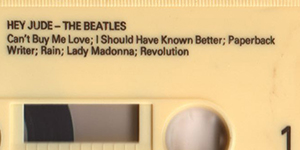 |
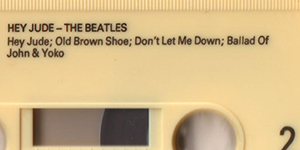 |
|||
| LABEL CLOSE UP | ||||
 |
"Made
in
England/Made in U.S.A" was not embossed on the
shell. |
|||
| OTHER ITEM | ||||
| - |
||||
| LABEL | Direct print in black ink on the shell
with Parlophone logo |
|||
| MIX | STEREO |
|||
| RECORD COMPANY'S NAME | EMI Records Ltd |
|||
| CENTRAL REMARK "SOLD IN U.K." |
- | |||
| RECORDING PUBLISHED CREDIT | (P) 1964,66, 68, 69 |
|||
| INLAY FORM | Custom inlay (Foldover) |
|||
| SHELL | Cream Shell Moulded Screw |
|||
| CASSETTE CASE |
"Norelco"
cases:
clear plastic at the front and around the spine area, and
black plastic at the rear. |
|||
| PRINTER CREDIT | Made and Printed in Great Britain |
|||
| COVER DESIGN/ PHOTO/ NOTES | Photo: Ethan Russell and Monte Fresco |
|||
| PRODUCER | George Martin | |||
| COMMENTS | This cassette tape has the
Parlophone logo printed directly onto the label in black
ink. The cream colored shell has screw molds and black lettering printed on the body, so the production date is estimated to be around 1986. The EMI UK catalog no. (TC-PCS 7184) was on the spine. The cassette cases ("Norelco" cases) were clear plastic at the front and around the spine area, and black plastic at the rear. Hey Jude (original title: The Beatles Again) is a 1970 collection of non-album singles and B-sides by the Beatles. Originally released in the United States and various other markets, but not in the United Kingdom, it consists of non-album singles and B-sides not previously issued on an American Beatles LP; this includes "I Should Have Known Better" and "Can't Buy Me Love", two singles released by Capitol Records whose only previous American album appearance had been on the A Hard Day's Night soundtrack album, which had been released by United Artists Records. It was also available to other countries as an "export" from Britain (Parlophone/Apple CPCS-106) but was not at first issued in Britain, although it was a popular import to the UK. Because of its popularity worldwide, EMI issued Hey Jude in Britain on the Parlophone label on 11 May 1979 (catalogue number PCS 7184). Until the release of 1967–1970 in 1973, Hey Jude was the only way to own the extremely popular "Hey Jude" single on LP or in a stereo mix. The songs "Rain", "Lady Madonna" and "Revolution" were also first mixed for stereo specifically for this album. (*1) EMI country code: 0C 262-06 864 The EMI country codes (introduced on 1 June, 1969): In most cases the EMI Codes are the first two letters of the record's catalog#. These EMI Country Codes were used to indicate the country in which the record was pressed. Note this doesn't necessarily means the record was also released in that country (from Discog). OC / 0C / 1E= UK DOLBY B-type: A Dolby noise-reduction system, or Dolby NR, is one of a series of noise reduction systems developed by Dolby Laboratories for use in analog audio tape recording. The first was Dolby A, a professional broadband noise reduction system for recording studios in 1965, but the best-known is Dolby B (introduced in 1968) for the consumer market, which helped make high fidelity practical on cassette tapes, which used a relatively noisy tape size and speed. From the mid-1970s, Dolby B became standard on commercially pre-recorded music cassettes. |
|||
|
TITLE
|
HEY JUDE |
|||
| CATALOG NUMBER | TC-PCS 7184 |
|||
|
RELEASE DATE
|
1987? / 5th Issue? | |||
| TRACK LISTING | SIDE 1 |
SIDE 2 |
||
| Can't Buy Me Love |
Hey Jude |
|||
| I Should Have Known Better |
Old Brown Shoe |
|||
| Paperback Writer |
Don't Let Me Down |
|||
| Rain |
Ballad Of John & Yoko | |||
| Lady Madonna | ||||
| Revolution | ||||
| CASSETTE CASE AND TAPE |
CASE FRONT | CASE BACK | SIDE 1 --> Click! | SIDE 2 --> Click! |
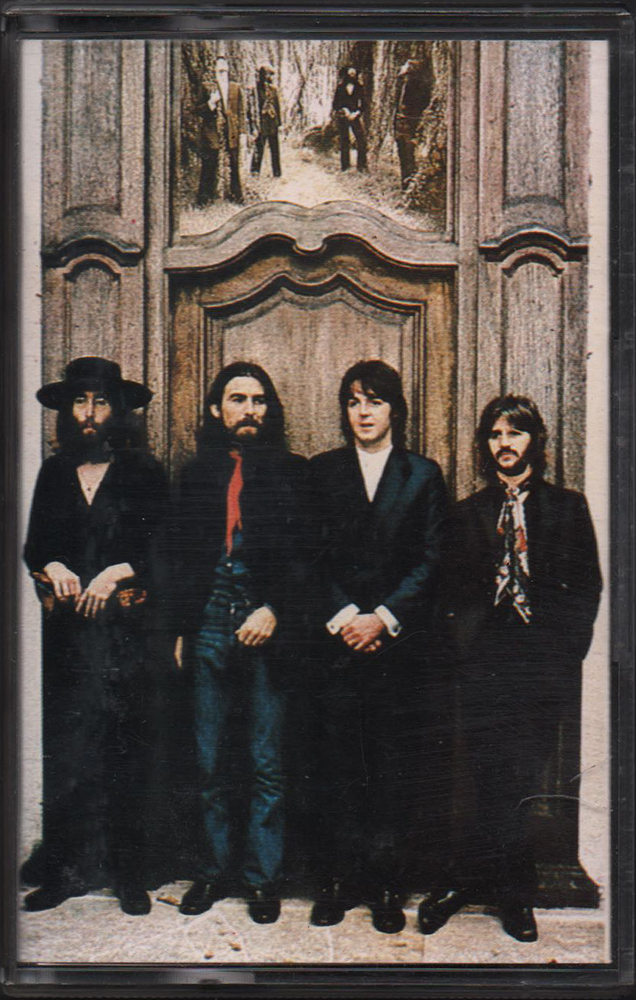 |
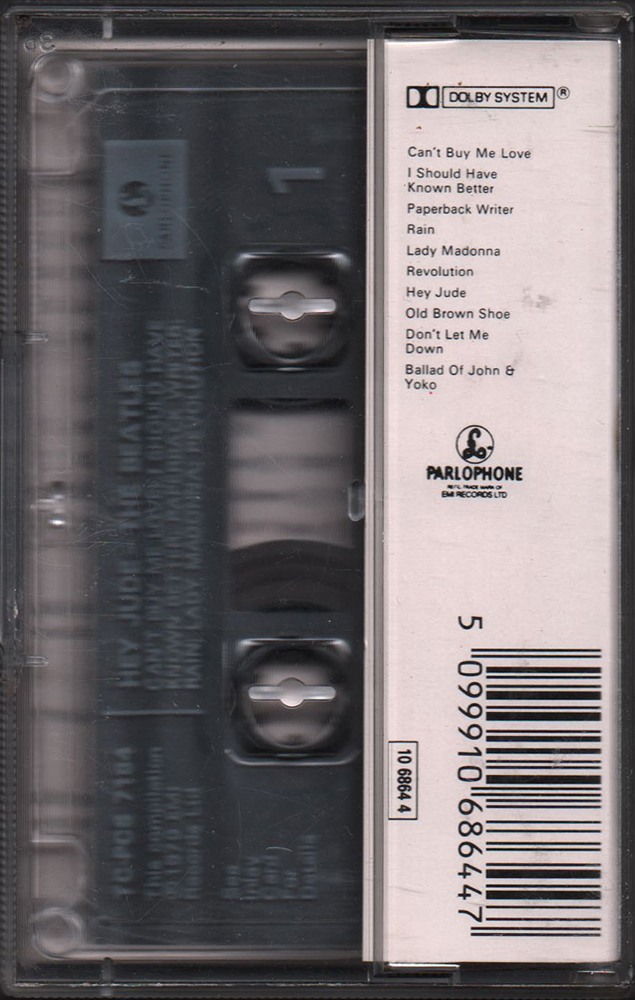 |
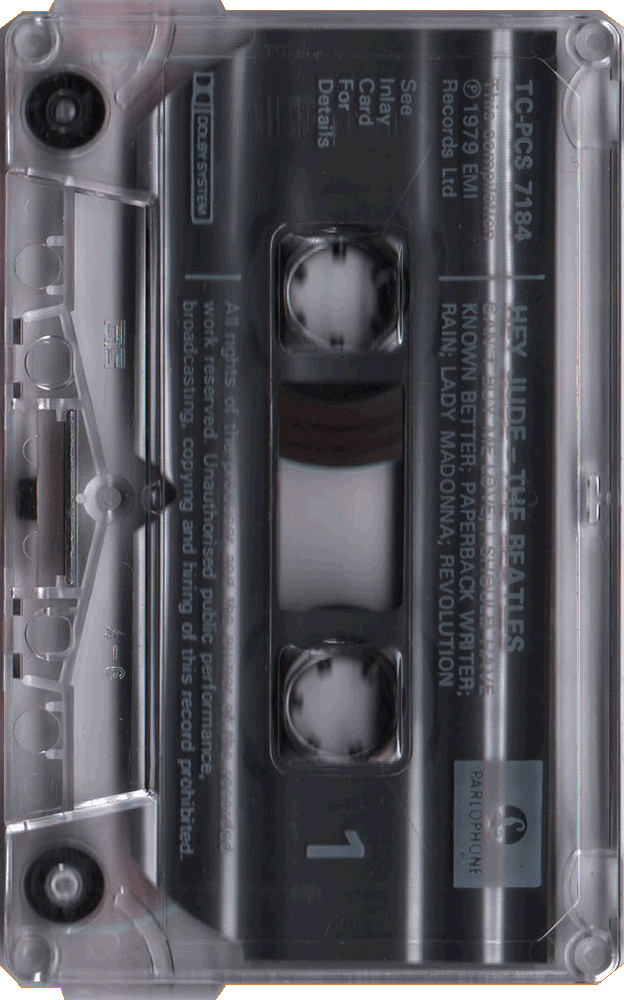 |
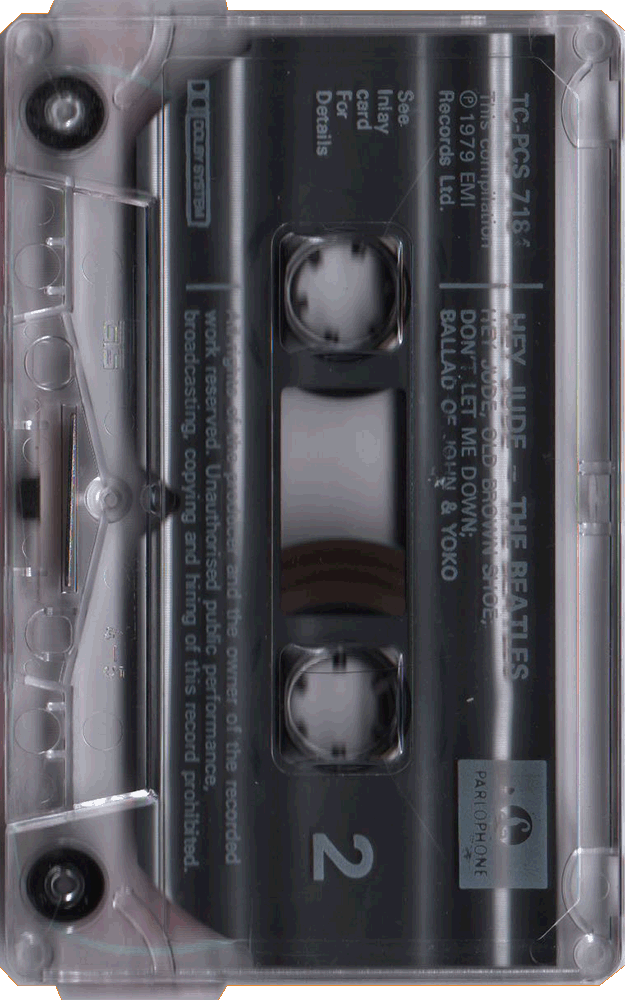 |
|
| The cassette cases ("Norelco" cases)
were clear plastic at the front and around the spine area,
and black plastic at the rear. |
Transparent Cassette shell with White on-body
print. Parlophone box logo on transparent cassette. |
|||
| INLAY |
INLAY: FRONT | INLAY: INSIDE |
||
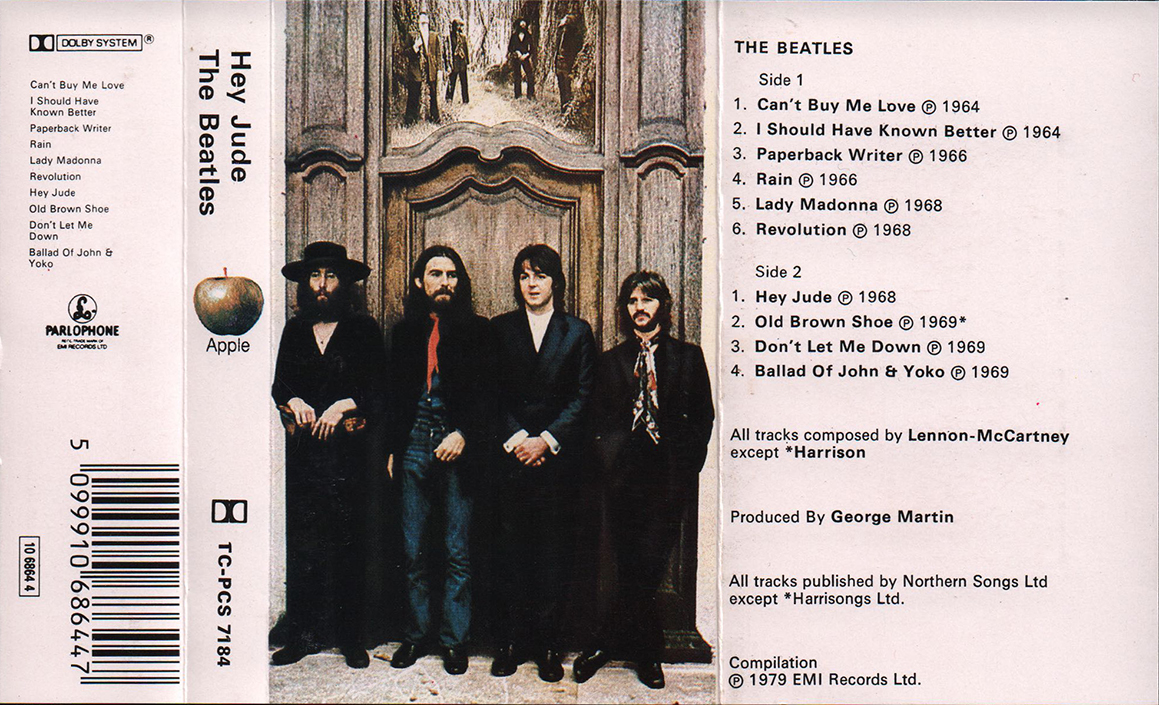 |
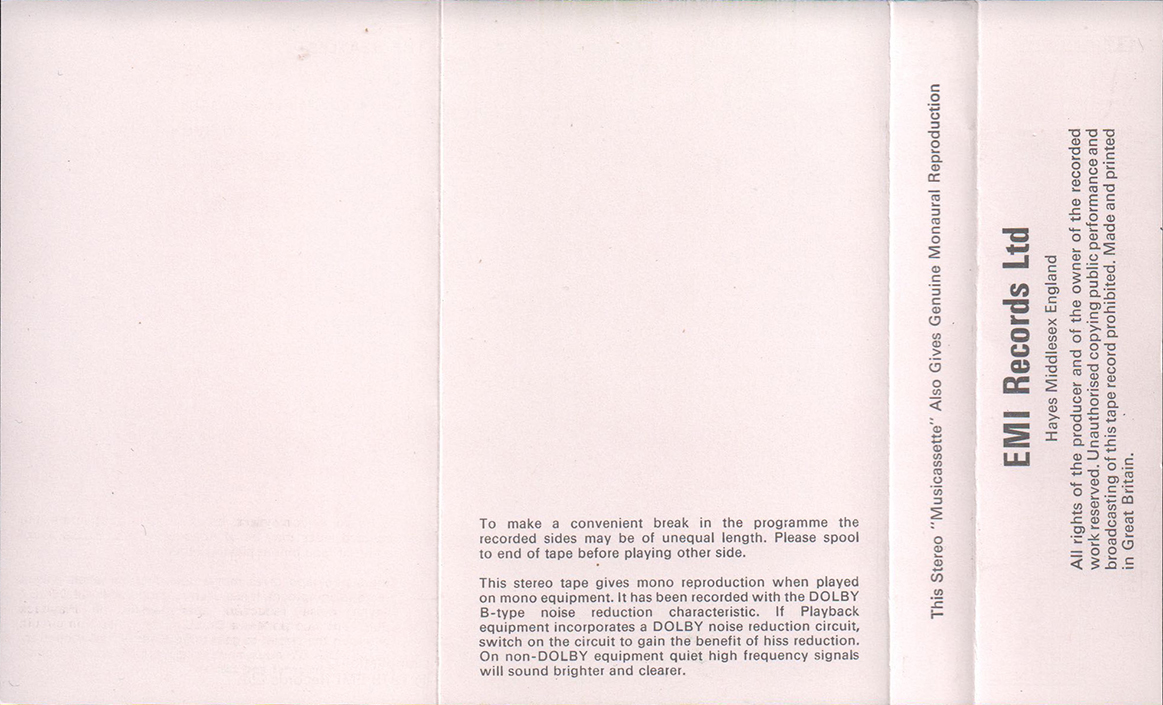 |
|||
| The front image of the inlay is the
same as that of the album "Hey Jude", but without the album
title printed on it. Parlophone "money" logo on back flap. |
||||
| INLAY: FRONT CLOSE UP | ||||
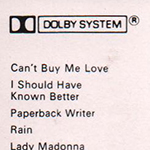 |
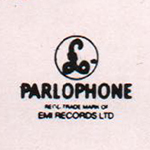 |
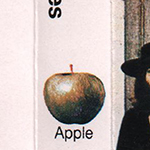 |
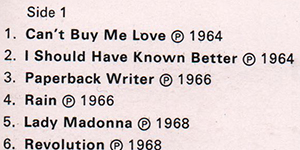 |
|
| The Parlophone logomark was printed on the inlay. "DOLBY SYSTEM" logo was printed on the inlay. | Apple logomark was
added on the inlay. |
The cassette of
the album "Hey Jude" is recorded in the same order as the
LP. |
||
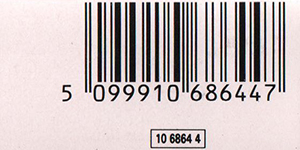 |
The flap has a
barcode. |
 |
||
| Catalog number
"TC-PCS 7184" and Dolby mark were printed on the inlay. EMI
country code (*1) was removed. |
||||
| INLAY: FRONT & INSIDE CLOSE UP | ||||
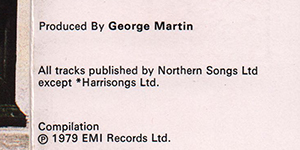 |
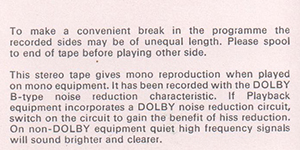 |
The phrase "It has been recorded with the
DOLBY B-type noise reduction characteristic" was printed.
Printer name and release date are not printed on
the inlay. |
||
| INLAY: INSIDE CLOSE UP | ||||
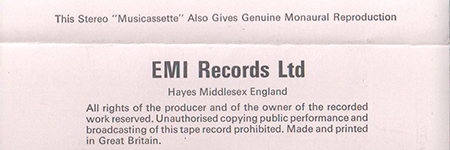 |
"EMI Records
Ltd Hayes Middlesex England" credit and "Made and
Printed in Great Britain" were printed at the bottom of the
inside of the inlay. |
|||
| LABEL CLOSE UP | ||||
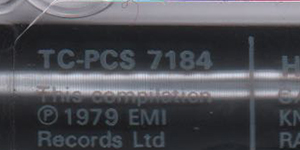 |
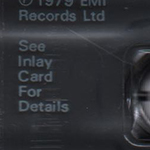 |
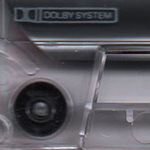 |
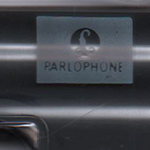 |
|
| "TC-PCS 7184"
catalogue number and "EMI Records Ltd." were printed. |
"See inlay card details" was printed. | "DOLBY SYSTEM" logo was
printed on the shell. |
The Parlophone logomark was printed on the shell. | |
| LABEL CLOSE UP | ||||
| SIDE 1 | SIDE 2 | The cassette label states, "See inlay card details" while also listing the track titles. | ||
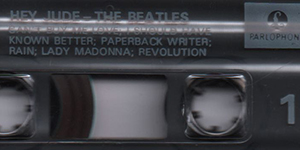 |
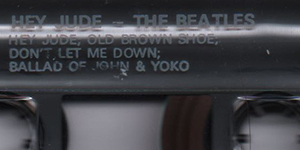 |
|||
| OTHER ITEM | ||||
| - |
||||
| LABEL | Transparent Cassette shell with White
on-body print |
|||
| MIX | STEREO |
|||
| RECORD COMPANY'S NAME | EMI Records Ltd |
|||
| CENTRAL REMARK "SOLD IN U.K." |
- | |||
| RECORDING PUBLISHED CREDIT | (P) 1964,66, 68, 69 |
|||
| INLAY FORM | Custom inlay (Foldover) |
|||
| SHELL | Transparent Cassette shell |
|||
| CASSETTE CASE |
"Norelco"
cases:
clear
plastic at the front and around the spine area, and black
plastic at the rear. |
|||
| PRINTER CREDIT | Made and Printed in Great Britain |
|||
| COVER DESIGN/ PHOTO/ NOTES | Photo: Ethan Russell and Monte Fresco |
|||
| PRODUCER | George Martin | |||
| COMMENTS | Double fold J card inlay, printed
both sides Transparent Cassette shell with White on-body print The EMI UK catalog no. (TC-PCS 7184) was on the spine. The cassette cases ("Norelco" cases) were clear plastic at the front and around the spine area, and black plastic at the rear. Hey Jude (original title: The Beatles Again) is a 1970 collection of non-album singles and B-sides by the Beatles. Originally released in the United States and various other markets, but not in the United Kingdom, it consists of non-album singles and B-sides not previously issued on an American Beatles LP; this includes "I Should Have Known Better" and "Can't Buy Me Love", two singles released by Capitol Records whose only previous American album appearance had been on the A Hard Day's Night soundtrack album, which had been released by United Artists Records. It was also available to other countries as an "export" from Britain (Parlophone/Apple CPCS-106) but was not at first issued in Britain, although it was a popular import to the UK. Because of its popularity worldwide, EMI issued Hey Jude in Britain on the Parlophone label on 11 May 1979 (catalogue number PCS 7184). Until the release of 1967–1970 in 1973, Hey Jude was the only way to own the extremely popular "Hey Jude" single on LP or in a stereo mix. The songs "Rain", "Lady Madonna" and "Revolution" were also first mixed for stereo specifically for this album. (*1) EMI country code: 0C 262-06 864 The EMI country codes (introduced on 1 June, 1969): In most cases the EMI Codes are the first two letters of the record's catalog#. These EMI Country Codes were used to indicate the country in which the record was pressed. Note this doesn't necessarily means the record was also released in that country (from Discog). OC / 0C / 1E= UK DOLBY B-type: A Dolby noise-reduction system, or Dolby NR, is one of a series of noise reduction systems developed by Dolby Laboratories for use in analog audio tape recording. The first was Dolby A, a professional broadband noise reduction system for recording studios in 1965, but the best-known is Dolby B (introduced in 1968) for the consumer market, which helped make high fidelity practical on cassette tapes, which used a relatively noisy tape size and speed. From the mid-1970s, Dolby B became standard on commercially pre-recorded music cassettes. |
|||